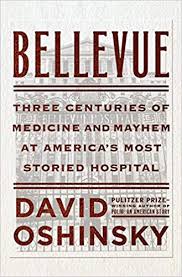Bellevue – More Than a Hospital
David Oshinsky is a Pulitzer-Prize winning historian, the kind of writer that is able to take a complicated story and render it entertaining, understandable and relevant. In 2016 he wrote Bellevue: Three Centuries of Medicine and Mayhem at America’s Most Storied Hospital. For those not in the know, Bellevue Hospital in New York City was the first public hospital founded in the United States – in 1736, before there even was a United States. In the centuries since, Bellevue has been at the center of virtually all major health issues, as well as front and center in the history of New York City. A vast hospital center today, Bellevue has been an important health site for thousands upon thousands.

Oshinsky’s book is a fast-moving and serious attempt to chart Bellevue’s development as modern public health emerged in the US. He places the institutional history of the hospital within economic, political and historical events, from the election of mayors to outbreaks of diseases. These narrative threads are woven into the history of advances in medicine and health. For example, the debates around germ theory, which was vitally important to medicine as well as Bellevue hospital, is examined through the lens of President Garfield’s assassination and the powerful figures leading the hospital. It makes for fascinating reading.
The hospital’s role in the development of forensic medicine is also extraordinarily interesting. When New York City moved from an elected to appointed coroner, the office was relocated at Bellevue Hospital. Much of modern forensic medicine began at Bellevue. And while the hospital did not have a research role in ending the AIDS crisis, the hospital’s role in attending, helping and addressing the crisis is another example that Oshinsky renders exceptionally well.
Size, location, and operating practices set Bellevue apart from most other hospitals. From its early years it was a teaching hospital and it has retained that commitment. It has also been a hospital that meets the needs of New Yorkers and the diverse immigrant community. That means that Bellevue staff often “see everything.” It has long been an innovator, an institution of many “firsts” – such as the site of the country’s first School of Nursing, first emergency room, first hospital with expertise and spaces for the insane, and so on. Lastly, the impact of the hospital on the city, and the corresponding impact of the city on Bellevue, provide a very useful lens to understand America’s largest municipality.
Oshinksy brings all of this to the page. It’s a very good book, surprisingly engaging. The history of Bellevue is much more than a history of a hospital.
David Potash